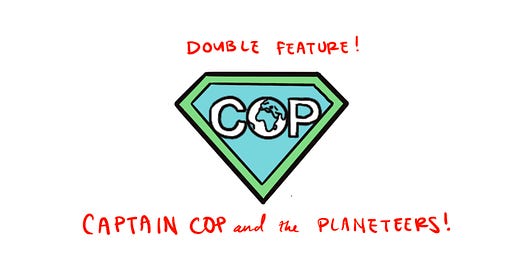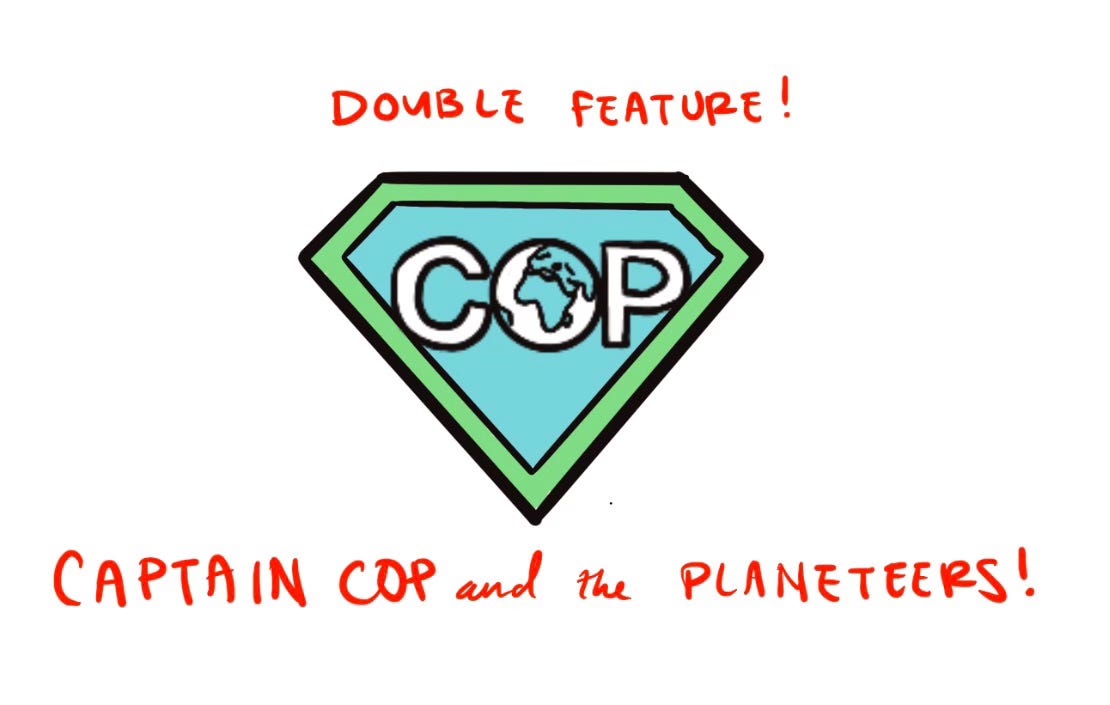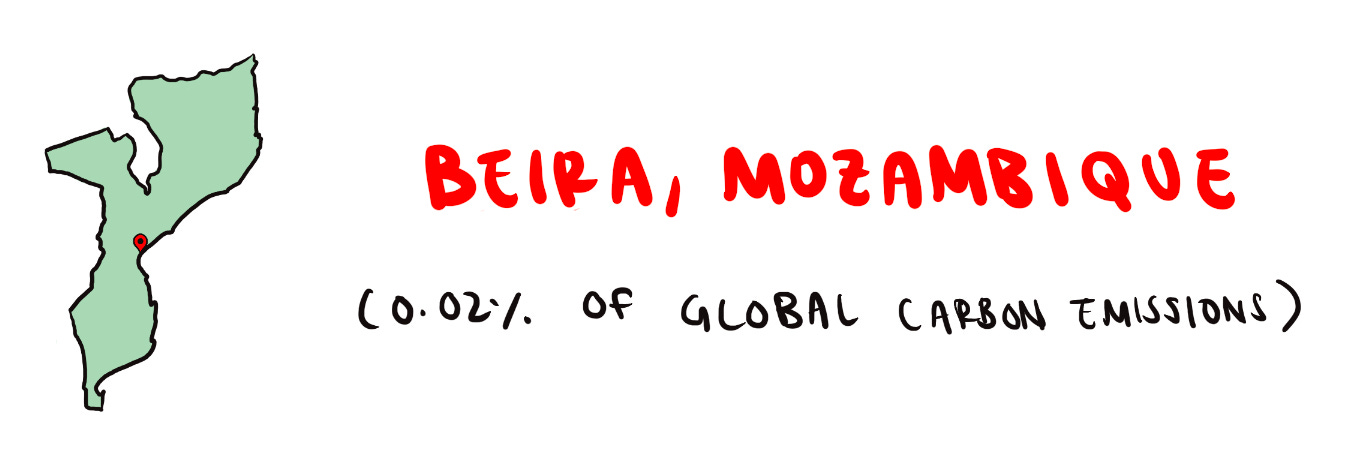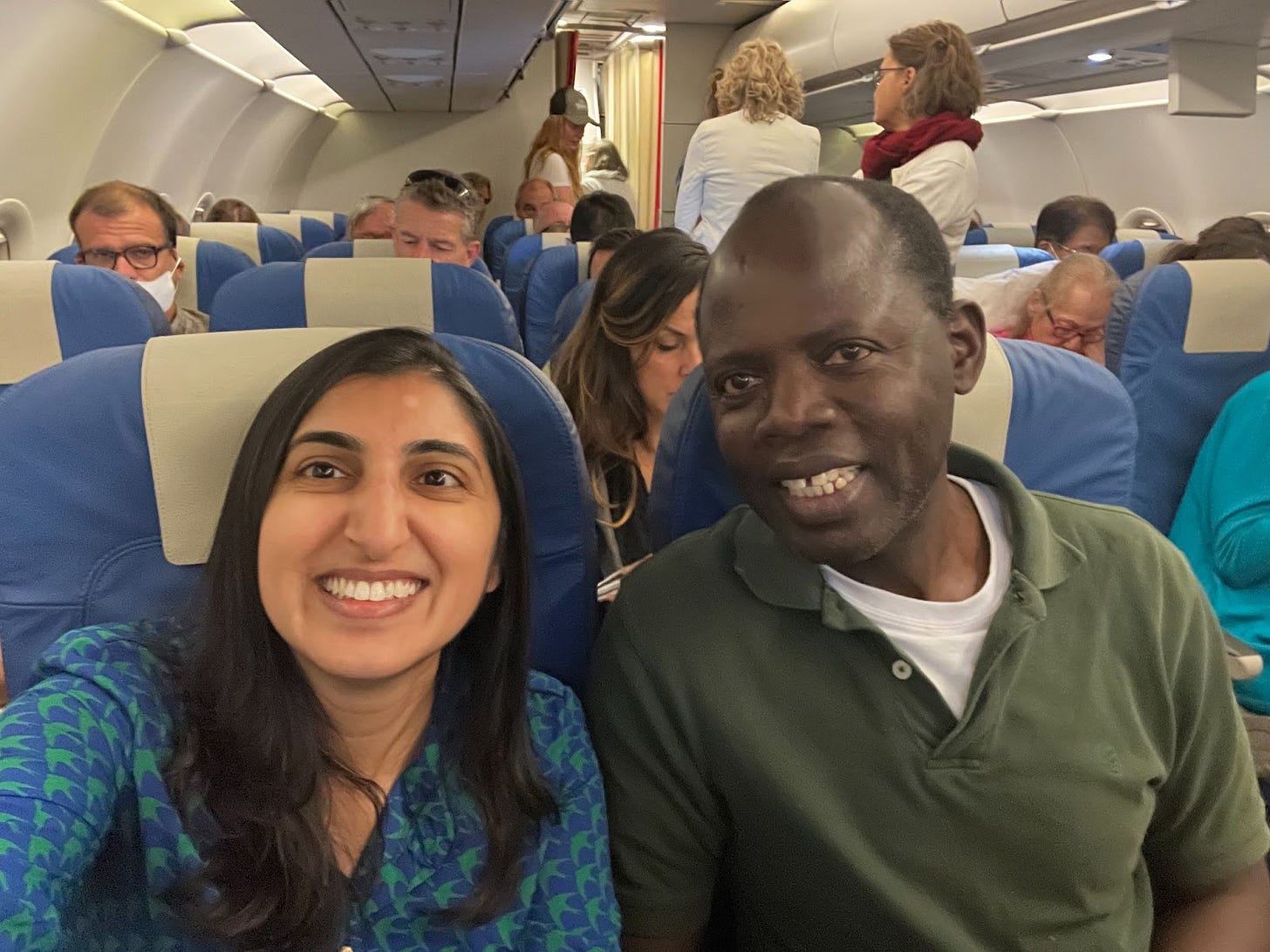Captain COP and the Planeteers
Beyond the Double Feature, the real superheroes are the green solutions
Imagine the scene: 44,000 climate aficionados from 190 countries come together (not once, but twice?!). A whole lot of debate. But amidst the wrangling, some good news, too.
We were lucky to close out the year at the UN COP27 Climate Change Conference in Sharm el Sheik, Egypt and the UN COP15 Biodiversity Conference in Montreal, Canada with our friends from across the globe. It's been a double feature of countries showcasing their climate investments, a series of late night negotiations between delegates, and some good old koshari and poutine to throw into the mix (those are links to recipes, for those wondering!).
There’s no shortage of deep dives on the main takeaways from these global climate extravaganzas. Take your pick from Reuters, NPR, CNN, Vox, The Guardian, and your favorite #climatetwitter celebrities (yes, last we checked, Twitter is still alive…).
Rather than dwelling on who wore their climate stripes best and how much carbon we all emitted while traveling, we’re going to focus the real heroes: climate solutions.
But first, some context.
It’s no secret that of the 1.5 trillion tonnes of CO2 the world has emitted since 1751, the rich countries of the “Global North” bear the brunt of the responsibility. The US accounts for about 25% of the total, the EU not far behind at 22%, and more recently China at 12.7%.
This is in contrast to the poor countries of the “Global South” that bear the brunt of the impact of climate change, from droughts causing massive famines in Somalia to floods putting one third of Pakistan underwater in a matter of days. For what it’s worth, Somalia accounts for 0.01% and Pakistan accounts for 0.5% of the world’s cumulative carbon emissions.
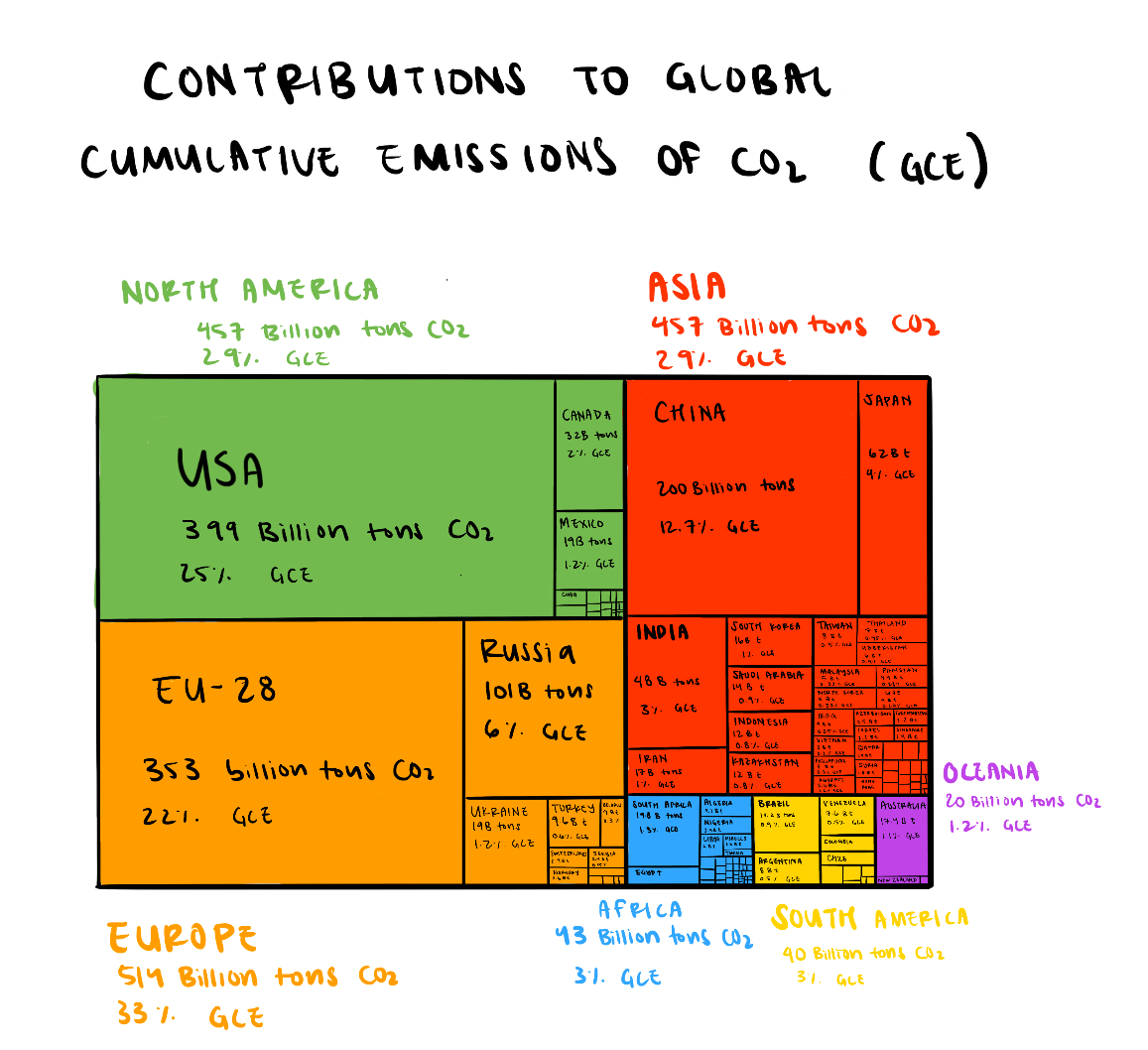
So, who’s supposed to pay for solutions to get us out of this mess?
November's COP27 hosted fierce negotiations over a Loss and Damage Fund, led by the indomitable Sherry Rahman, Pakistan’s Minister of Climate Change (she says it like it is: What Goes on in Pakistan Won’t Stay in Pakistan). In its simplest form, loss and damage acknowledges that high income countries whose economic growth caused the climate crisis should compensate their lower-income counterparts who are now paying the price for that growth.
To our immense surprise, these negotiations ended with 190 countries agreeing to establish a Loss and Damage Fund — 30 years after the concept was first proposed. This is a huge win for the history books. But now comes the hard part. Who will manage the fund? How large will it be? Who contributes what? How do countries access scarce resources? How will the money be distributed? What types of projects will be funded? The list of questions goes on.
The answer: We’ve got to nurture nature
While that all gets figured out, we thought this would be a good opportunity to explore the types of solutions a Loss and Damage Fund might finance throughout the Global South.
Shockingly, we didn’t have a chance to talk to all 44,000 delegates, but we made the rounds and got into the weeds. In imagining a more beautiful, climate-resilient future, a key theme emerged: we’ve got to nurture nature.
At COP15 in Canada, 190 nations signed the Global Biodiversity Framework to protect 30% of land and 30% of oceans by 2030. We’re finally recognizing how natural ecosystems and biodiversity play a critical role in supporting life on Planet Earth. You wouldn’t be reading this if it weren’t for the oft-invisible processes of nature — from sequestering our carbon to protecting our coasts to purifying our air. All told, services provided by nature are worth $125 trillion annually. Trillion with a T.
In cities, investments in nature pay for themselves. Our friends at the Rocky Mountain Institute did the math: urban nature generates 9x as much value as the cost, especially when it comes to public health. We’re talking VC-level returns here! But rather than going into the pockets of a handful of people, these benefits are shared by humanity at large.

But wait, there's more! We have a significant investment opportunity at hand. A nature-positive pathway for infrastructure and the built environment can create over $3 trillion of business opportunities and 117 million jobs by 2030. This is Climate Industrialism in practice, rooted in green development.
It’s about time that we not only protect and preserve nature, but nurture it. These are co-benefits at their best; by leveraging nature in how we address climate change, we can create beautiful, healthy, and livable cities for everyone to enjoy, our favorite critters included.
Solutions: Nature Tech, the superheroes in action!
Since we’re all about solutions, here’s our favorite sampling of nature based solutions for climate adaptation and mitigation, with a side of new age technology. These are all from communities in the Global South that are most impacted by climate change - we’re excited to see these ideas scale across the world!
World Bank, IFC, USAID, DFID, GTZ, and the acronym soup of global financing organizations: we hope you’re paying attention!
When Cyclone Idai and Cyclone Kenneth led to 600 deaths in Mozambique, Mayor Daviz Simango of the coastal city of Beira took matters into his own hands. Home to 600,000 people and the country’s major port, Beira is one of the 20 most vulnerable cities in the world.
But today, it’s recognized as Africa’s leading city to flip the script to rebuild for resilience. Along with stormwater drainage and retention systems complete with state-of-the-art StormSensors to track water flows in real time, the government has built a 44-acre multi-functional urban park along the Chiveve River to reduce urban flooding. It’s basically a giant green sponge, holding back water from the rest of the city.
The ambitious project also includes public spaces that simply make people happy: a botanical garden, community theater, local markets, and pedestrian and bike friendly routes. And it works – this year when an equally strong Cyclone Eloise arrived, less than 10 people were injured and nobody perished. More of this, please!
A 101% growth rate? Yes, that’s right. Nairobi, Kenya, is already the second fastest growing city in the world and is expected to take the top spot in the urbanization league tables by 2050. And what comes with more people? More trash!
In Nairobi, 55% of the 835,800 tons of solid waste generated every year is organic waste – much of which goes to landfill and releases huge amounts of methane into the atmosphere. The city faces urgent pressure to develop waste management solutions, as increased urbanization is leading to increased risk of air, water, and soil pollution.
Enter Sanergy: a (profitable!) circular economy startup that converts trash to treasure, literally. Sanergy leverages nature’s method of waste conversion, using Black Soldier Fly Larvae to consume organic waste. The flies then poop out two byproducts: a protein-rich, organic fertilizer and biomass fuel briquettes. Good shit (pun intended!). Sanergy is ready to take this show on the road, and plans to expand across Africa, providing a viable solution for a waste-free future!
Wetlands reduce flood risk in cities across the world — often holding excess water during large rainfall events. However, the capacity of the Beddagana wetlands in Colombo, Sri Lanka dropped 40% over the past decade as development soared to keep up with population growth. Half of the country’s poorest residents live in the capital city, and the government has launched an ambitious program of economic and physical regeneration for the Metro Colombo area.
Students and faculty at the University of Sri Jayewardenepura created a lab to analyze soil core samples from different parts of the wetlands and measure their organic carbon content — eventually hoping to join verified carbon offset programs. This link between nature, sustainability, and finance is critical, and it'll be enabled by technologies like drones and precision imaging cameras that can remotely track and predict sequestration levels on a regular basis. (Side note: check out a similar project along the Hudson River in New York led by geospatial analytics startup Perennial!) Bonus points: sensors show visibly cooler ground-level temperatures and data from the local utility shows reduced AC use in areas close to the wetlands.
Our favorite part? The new wildlife sanctuary that has emerged has increased biodiversity in the capital by a whopping 50%. Say hello to the saltwater crocodiles and purple faced leaf monkeys next time you’re in town!
With extreme heat wreaking havoc all over the world, no country is immune. This is especially the case in India, where approximately 89,000 people die each year due to heat exposure. In cities, the consequences are even more dire, with the urban heat island effect raising street level temperatures up to 9F degrees.
To solve this problem, Microsoft is working with geospatial analytics startup Gramaneer and local nonprofit Sustainable Environment and Ecological Development Society (SEEDS) to integrate topography, land surface temperatures, and weather data with AI tools – all at an accuracy of 30 meters. The Scenario Modeling View even enables them to integrate changes in building count and height, urban sprawl, vehicular traffic, and other factors. The data is collated with citizen science efforts, with schoolchildren ground-truthing the information on an open data platform. (Side note: For those who want to get in on the citizen science action, NOAA wants to partner with you to map urban heat island effects in your community!)
The city of Bhubaneswar, India is using these tools to pinpoint which parts of the city are most at risk for urban heat island effects and intervene before it’s too late. The city recently instituted an early warning app to inform residents about heat waves and provide information on cooling centers. It's also using the geospatial data to pinpoint locations for nature based solutions such as water features, green roofs, and even new Miyawaki forests in the heart of the city!
The Post-Credit Scene
There are a lot of reasons to be critical of COP. But 44,000 people all brave the endless negotiations, lackluster food, transportation delays, and logistics snafus for a reason: It’s the climate community.
We’ll sign off with a photo of Sonam and her new friend, Dr. Wassila Thiaw, International Director of NOAA’s Climate Prediction Center. A native of Senegal, Dr. Thiaw launched NOAA’s Africa Desk in 1994 to assist countries in building their meteorological and hydrological services, helping predict major floods, typhoons, droughts, and other hazards. He was at the first COP in Berlin in 1995, and Sonam was lucky enough to chat with him about the weather for 6 hours as they flew out of the latest COP, 27 years later.

